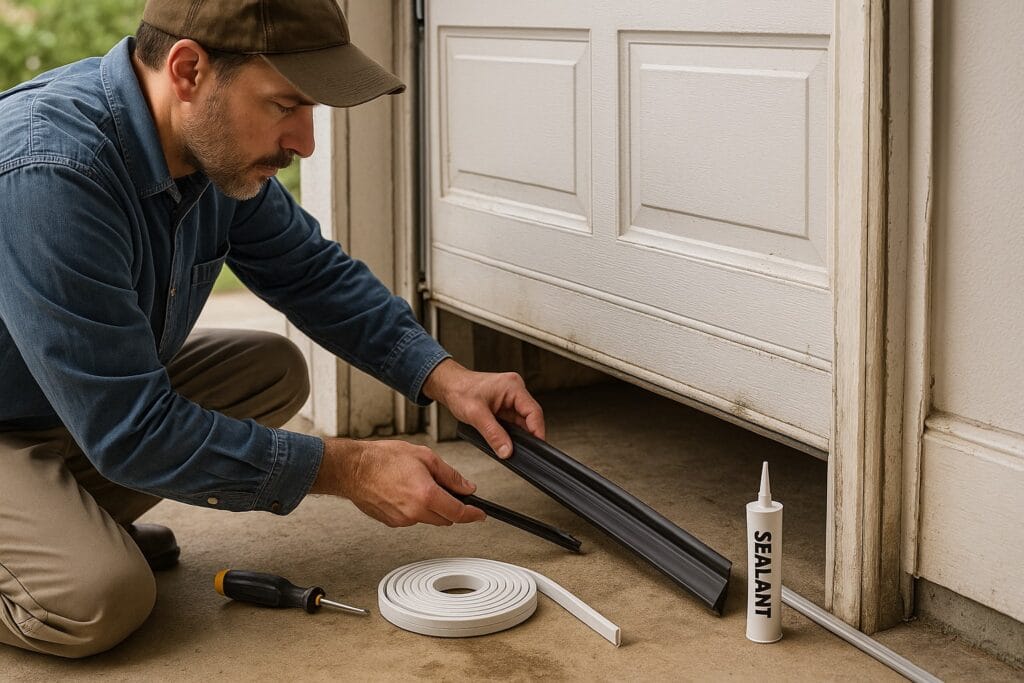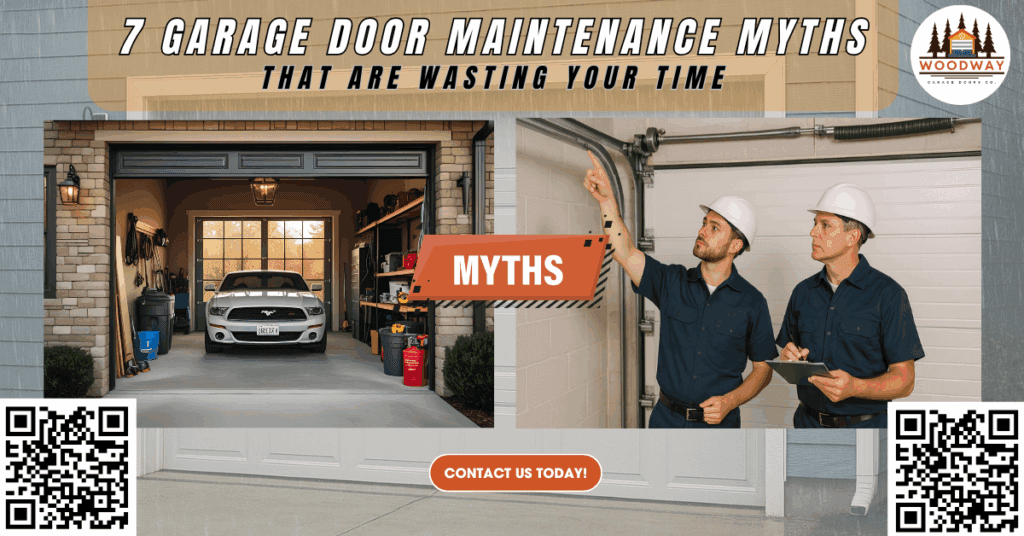When Mr. Thompson from Houston began hearing a loud screech every morning as his garage door opened, he figured it was nothing serious. Like many homeowners, he grabbed a can of WD-40, sprayed the hinges, and moved on. But the problem only got worse. After a few weeks, his garage door stopped functioning completely. When he called our team at Woodway Garage Doors Co., we discovered the real culprit: a failing torsion spring and dry, misaligned rollers.
This situation is surprisingly common. Over 35% of garage door repair calls we handle in the Houston area stem from simple misunderstandings about garage door maintenance. Misinformation leads to wasted time, preventable damage, and costly repairs.
As a trusted name in garage door service in Houston, TX, we’re here to set the record straight. Let’s bust the most common myths about garage door maintenance so you can protect your investment, keep your home safe, and avoid unnecessary stress.
Myth #1: “Garage Doors Don’t Need Maintenance If They’re Working Fine”
Many homeowners believe that if their garage door opens and closes without issue, it’s running just fine. But that assumption ignores how garage doors function. A typical garage door has more than 300 moving parts, including rollers, springs, cables, hinges, and garage door openers, all of which wear down over time.
Neglecting regular maintenance can lead to:
- Excessive wear on torsion springs and extension springs
- Misaligned garage door tracks
- Failing sensors and safety features
- Loud or jerky operation
- Full breakdowns that require emergency service
Just like a car, a garage door system benefits from regular check-ups. Every time the door operates, parts undergo stress. These repeated cycles eventually lead to fatigue. Without intervention, minor issues can evolve into severe complications that demand costly replacement of parts or the entire door.
Preventative maintenance isn’t about fixing what’s broken. It’s about preventing breakdowns in the first place. A quick visual inspection, applying garage door lubricant, checking the cables and sensors, cleaning the tracks, and tightening loose hardware are all smart tasks to perform every 6-12 months. In areas like Houston, where weather can accelerate wear and tear, a bi-annual inspection is even more important.
The truth: If you wait until something goes wrong, you’ll likely pay more in time and money.
Myth #2: “Spraying WD-40 Is All the Lubrication It Needs”
Let’s get this straight: WD-40 is not a lubricant. It’s a solvent meant to displace water and clean rust. If you’re spraying WD-40 on your garage door parts, you’re likely stripping away needed grease from metal parts and attracting dust, debris, and grime that accelerate wear.
Proper lubrication is crucial for maintaining smooth operation, minimizing noise, and extending the life of moving parts. Neglected lubrication can cause metal-on-metal contact, which leads to damaged rollers, worn-out hinges, and even bent tracks. These problems, if left unchecked, can halt the function of the entire garage door system.
For quiet and reliable operation, use the right lubricant:
- White lithium grease for hinges, torsion springs, and opener chains
- Silicone spray lubricant for weatherstripping, nylon rollers, and plastic components
Before applying fresh lubricant, always clean off old grease and accumulated debris using a clean cloth or brush. Use sparingly, too much grease can trap dirt, while too little won’t protect the parts.
Focus your lubrication efforts on:
- Rollers and roller brackets
- Hinges
- Torsion springs
- Bearings
- Arm bar
- Metal contact points on the track
- Chain or screw drive of the opener
The truth: Use dedicated garage door lubricant, not household products like WD-40. Regular lubrication is one of the simplest and most effective forms of garage door maintenance.

Myth #3: “The Opener Does All the Heavy Lifting”
Many believe that the garage door opener is the only component responsible for lifting and lowering the door. In reality, the springs do most of the work. The garage door opener is there to guide and control movement, not carry the load.
Garage doors can weigh anywhere from 130 to 400 pounds. The opener motor would burn out quickly if it had to carry all that weight unassisted. Instead, torsion springs and extension springs are engineered to counterbalance the weight of the door. This design allows for effortless lifting by the opener or manual opening during power outages.
When springs become weak or break, it places unnecessary stress on the opener. Common signs of spring failure include:
- Door feels heavy when lifted manually
- Door stops mid-operation
- Loud popping or snapping sounds
- Opener struggles to lift the door
If you suspect spring issues, never attempt to adjust or replace them yourself. The tension stored in torsion springs is powerful and can cause serious injury.
Perform a balance test: Disconnect the automatic opener using the release handle and lift the door halfway. If it stays in place, the springs are fine. If it falls, the springs are worn or broken.
The truth: Springs do the lifting; openers do the guiding. Weak springs = overworked opener = costly repairs.
Myth #4: “All Garage Door Repairs Are DIY Friendly”
We love a good DIY guide, but when it comes to garage door maintenance, safety comes first. Garage doors can weigh 150 to 300+ pounds, and springs are wound tightly under extreme tension. One misstep while adjusting cables or bolts can result in serious injury.
According to the Family Handyman and national safety statistics, over 15,000 injuries per year in the U.S. are garage door-related. Most involve:
- Broken garage door springs
- Snapped cables
- Falling doors due to failed parts
- Unsafe ladder use while inspecting or repairing doors
Even simple maintenance tasks can become dangerous without the right tools, such as a socket wrench, safety gloves, or a ladder with proper footing. Attempting to adjust torsion springs, fix roller brackets, or replace cables is risky without training.
Tasks safe for DIY include:
- Visual inspections
- Cleaning debris from tracks
- Lubricating rollers and hinges
- Replacing remote batteries
For more complex issues, such as spring replacement or realigning tracks, it’s best to call a professional.
The truth: It’s not worth the risk. Leave complex repairs to trained experts.
Myth #5: “Garage Door Maintenance Is Just a Quick Visual Check”
A quick glance might catch obvious rust spots or a hanging cable, but it won’t identify deeper issues such as a slightly bent track, tension loss in the springs, or failing sensors. A thorough inspection involves a step-by-step guide of tasks that ensure every part is performing safely and effectively.
Here’s what a comprehensive maintenance routine includes:
- Inspecting all moving parts
- Checking the tightness of all bolts, nuts, and roller brackets
- Ensuring the door is properly balanced
- Testing the auto-reverse feature by placing an object under the door
- Cleaning and lubricating tracks, rollers, and hinges
- Verifying sensor alignment and cleaning lenses
- Examining the weatherstripping for signs of cracking or gaps
- Listening for unusual noises during operation
This kind of detailed care improves safety, efficiency, and longevity. It also helps prevent costly repairs by catching minor issues early.
The truth: Proper garage door maintenance requires more than a glance—it’s a hands-on, multi-step process.
Myth #6: “You Can Ignore Weather Seals and Bottom Rubber Strips”
Houston’s climate is humid and unpredictable, which means moisture and dirt are always a threat. Your garage door weatherstripping and bottom seal protect your garage from:
- Water damage from flooding or rain
- Dust and debris accumulation on moving parts
- Insect infestations that could damage items in storage
- Hot and cold air seepage, which affects energy efficiency
Worn or damaged seals create entry points for outside elements, which can cause rust, mold, and even pest infestations. Replacing these seals takes minutes and significantly extends the life of your garage door system.
Make sure to:
- Check seals for cracking, separation, or flattening
- Replace the bottom rubber strip every 2-3 years, or sooner in harsh conditions
- Apply sealant where needed to prevent air gaps
The truth: Weather seals are a critical part of your garage door’s protective system.

Myth #7: “Smart Garage Doors Don’t Require Manual Checks”
Modern garage door openers, including brands like Stealth Drive Connect, come with fantastic features: smartphone integration, automatic close timers, and safety sensors. But even the best smart door opener can’t detect physical issues like:
- Loose roller brackets
- Warped tracks
- Frayed cables
- Rusted torsion springs
These high-tech systems are designed for convenience but rely on the mechanical parts functioning correctly. A smart alert might tell you the door didn’t close properly, but not why. If a cable is about to snap or a hinge is about to fail, you won’t get a warning.
Don’t let the presence of smart features lull you into a false sense of security. Regular manual inspections and tests remain critical.
The truth: Smart tech adds convenience but doesn’t replace manual maintenance.
Final Thoughts: Why Maintenance Matters More Than You Think
Garage door systems are intricate, heavy-duty mechanisms that play a vital role in your home’s safety and convenience. Ignoring regular care or relying on misinformation can result in serious consequences, from expensive repairs to dangerous malfunctions.
Think of your garage door like a car engine. It needs fuel (lubrication), regular service (inspections), and attention to detail (safety checks). Keeping it running smoothly protects your investment, ensures security, and improves the quality of life for your family.
The good news? Most garage door maintenance tasks take under an hour and only require basic tools. Create a maintenance calendar, schedule professional inspections annually, and educate your household on the importance of safe garage door operation.
By staying informed and proactive, you’ll enjoy:
- Quieter operation
- Fewer emergency garage door repairs
- Longer-lasting garage door parts
- Safer home entry for your family
Make maintenance a habit, not an afterthought.
How Can Woodway Garage Doors Co. Help You?
At Woodway Garage Doors Co., we specialize in helping homeowners and businesses in Houston and surrounding areas get the most out of their garage doors.
Whether you need help with:
- Routine garage door maintenance
- Emergency spring or cable repair
- New door installation
- Custom upgrades for wood doors or steel garage doors
Our experienced team is here to deliver top-notch service with a smile.
We offer:
- Thorough safety inspections
- Regular maintenance plans
- Expert repairs for all garage door parts
- The right tools, from garage door lubricants to precision cable adjustments
- Friendly technicians who explain every step of the process
📍 Visit Us:
4900 Woodway Dr ste 1110, Houston, TX 77056, United States
📞 Call Today:
(214) 296-9993
Don’t let garage door myths waste your time or risk your safety. Schedule your garage door maintenance appointment with Woodway Garage Doors Co. today!
Frequently Asked Questions (FAQs)
1. How often should I lubricate my garage door components?
Lubricate all moving metal parts every 6 months for optimal performance and quiet operation.
2. What should I do if my garage door makes a grinding noise?
A grinding noise often indicates a lack of lubrication or a misalignment; inspect the rollers and tracks or call a technician if the noise persists.
3. Can I replace just one spring on a double spring system?
It’s recommended to replace both springs at the same time to ensure balanced operation and extend the lifespan of your garage door system.
4. Are insulated garage doors worth the investment?
Yes, insulated doors help regulate your garage temperature, reduce noise, and enhance energy efficiency, especially in climates like Houston’s.

